2024届高考英语二轮总复习 写作专项提升 读后续写 3大策略课件(共37张PPT)
文档属性
| 名称 | 2024届高考英语二轮总复习 写作专项提升 读后续写 3大策略课件(共37张PPT) |  | |
| 格式 | pptx | ||
| 文件大小 | 157.9KB | ||
| 资源类型 | 教案 | ||
| 版本资源 | 通用版 | ||
| 科目 | 英语 | ||
| 更新时间 | 2024-04-20 23:16:54 | ||
图片预览

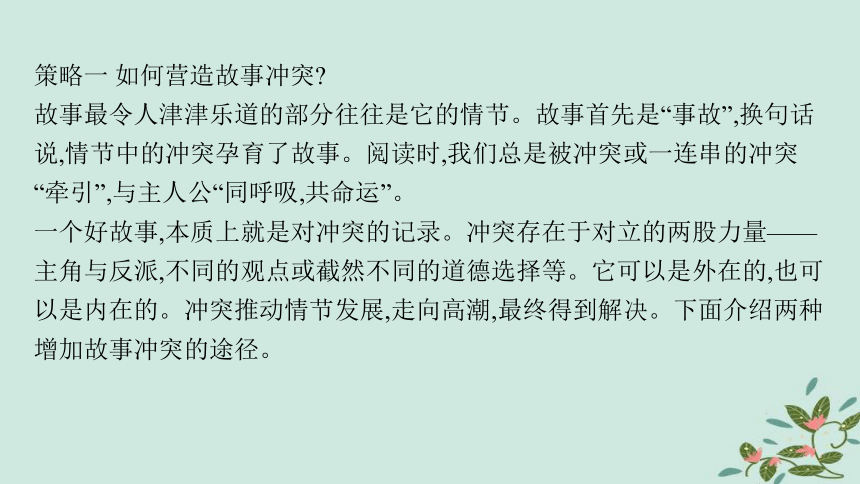
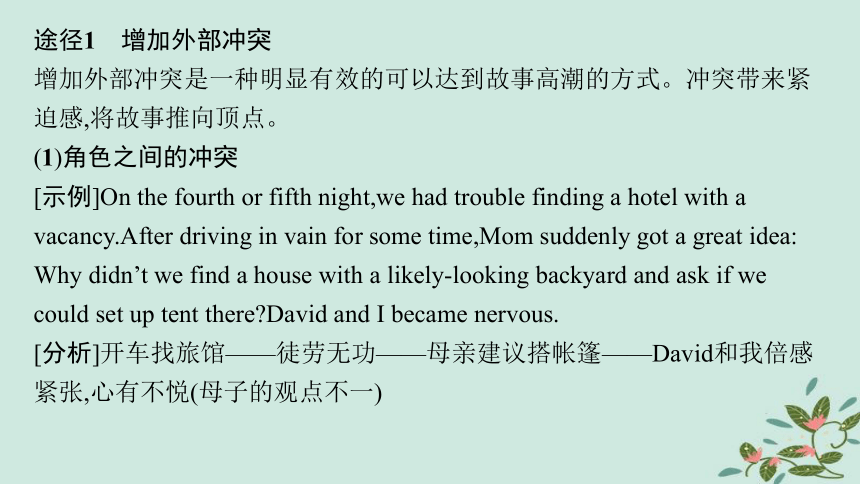
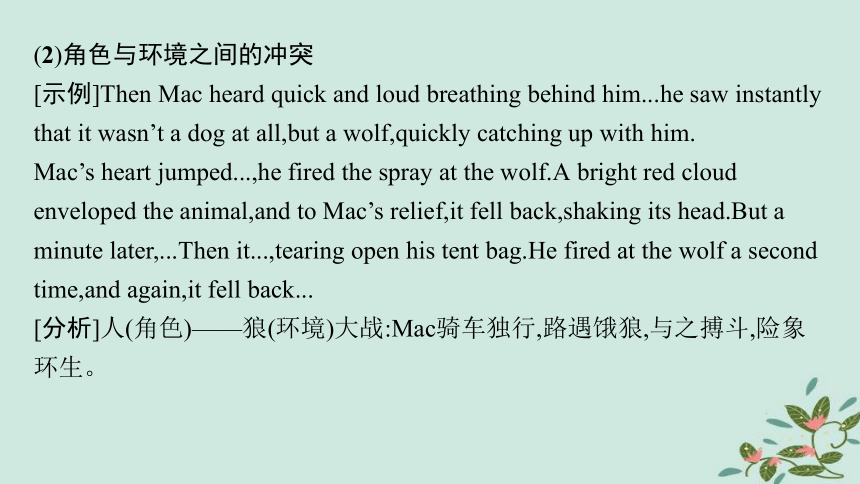
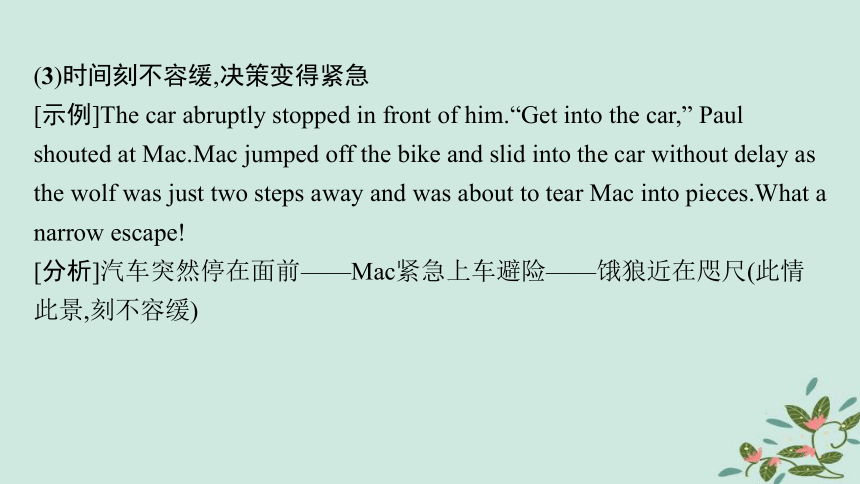
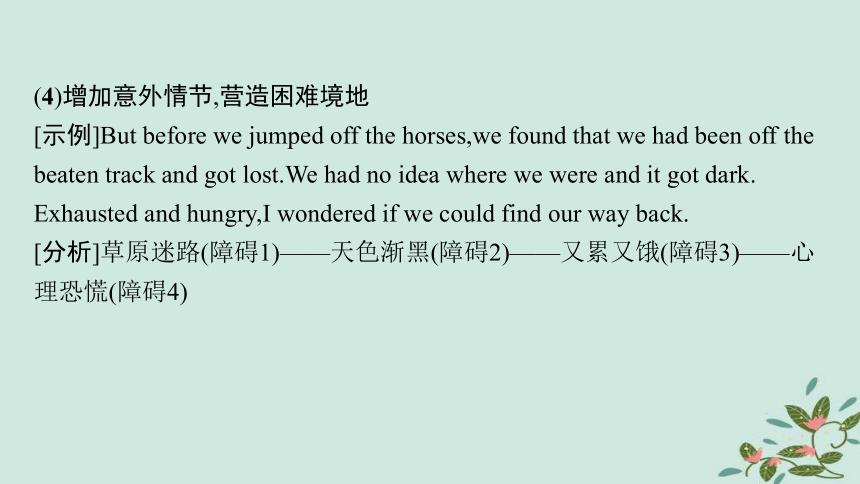

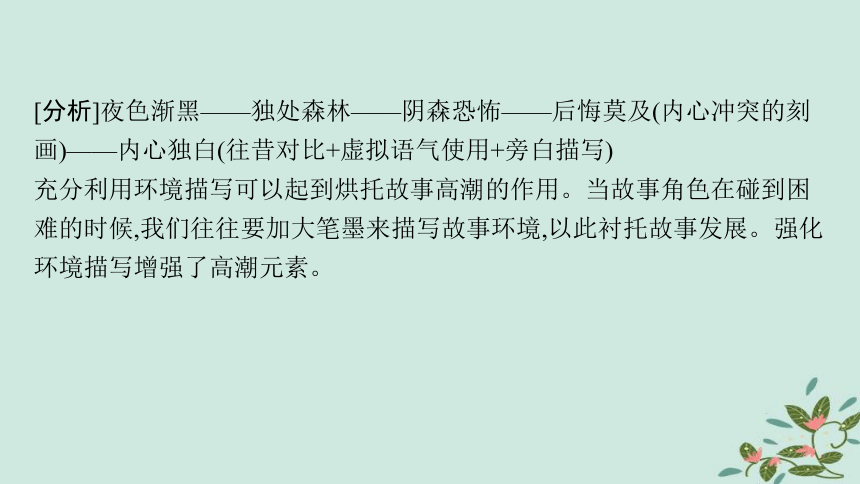



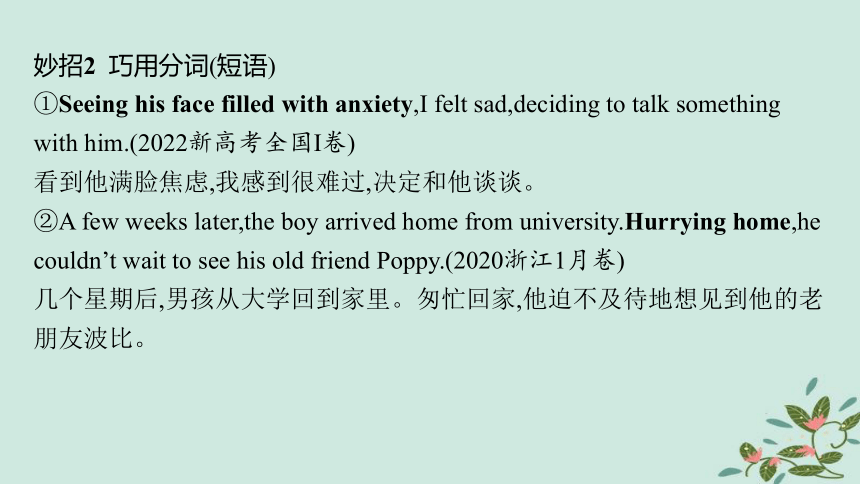
文档简介
(共37张PPT)
第四讲 3大策略,营造高分亮点
策略一 如何营造故事冲突
故事最令人津津乐道的部分往往是它的情节。故事首先是“事故”,换句话说,情节中的冲突孕育了故事。阅读时,我们总是被冲突或一连串的冲突“牵引”,与主人公“同呼吸,共命运”。
一个好故事,本质上就是对冲突的记录。冲突存在于对立的两股力量——主角与反派,不同的观点或截然不同的道德选择等。它可以是外在的,也可以是内在的。冲突推动情节发展,走向高潮,最终得到解决。下面介绍两种增加故事冲突的途径。
途径1 增加外部冲突
增加外部冲突是一种明显有效的可以达到故事高潮的方式。冲突带来紧迫感,将故事推向顶点。
(1)角色之间的冲突
[示例]On the fourth or fifth night,we had trouble finding a hotel with a vacancy.After driving in vain for some time,Mom suddenly got a great idea: Why didn’t we find a house with a likely-looking backyard and ask if we could set up tent there David and I became nervous.
[分析]开车找旅馆——徒劳无功——母亲建议搭帐篷——David和我倍感紧张,心有不悦(母子的观点不一)
(2)角色与环境之间的冲突
[示例]Then Mac heard quick and loud breathing behind him...he saw instantly that it wasn’t a dog at all,but a wolf,quickly catching up with him.
Mac’s heart jumped...,he fired the spray at the wolf.A bright red cloud enveloped the animal,and to Mac’s relief,it fell back,shaking its head.But a minute later,...Then it...,tearing open his tent bag.He fired at the wolf a second time,and again,it fell back...
[分析]人(角色)——狼(环境)大战:Mac骑车独行,路遇饿狼,与之搏斗,险象环生。
(3)时间刻不容缓,决策变得紧急
[示例]The car abruptly stopped in front of him.“Get into the car,” Paul shouted at Mac.Mac jumped off the bike and slid into the car without delay as the wolf was just two steps away and was about to tear Mac into pieces.What a narrow escape!
[分析]汽车突然停在面前——Mac紧急上车避险——饿狼近在咫尺(此情此景,刻不容缓)
(4)增加意外情节,营造困难境地
[示例]But before we jumped off the horses,we found that we had been off the beaten track and got lost.We had no idea where we were and it got dark. Exhausted and hungry,I wondered if we could find our way back.
[分析]草原迷路(障碍1)——天色渐黑(障碍2)——又累又饿(障碍3)——心理恐慌(障碍4)
途径2 放大内心冲突
放大内心冲突(文中角色的内心斗争)有助于抓住读者的心,让读者感同身受,一步步将读者带入情境、融入其中,有助于制造故事波澜和冲突。
[示例]Immediately,an absolute darkness ruled the forest.Jane,exhausted and scared,lay down near a stone,missing her family at a distance.All the fantastic memory crowded in and she couldn’t help crying,“Hadn’t I quarrelled with Tom,walked away and climbed to the high place,I wouldn’t be trapped in this awful place,confronted with the danger of dying.” She regretted with endless anxiety,and then became asleep with shining tears in her eyes.
[分析]夜色渐黑——独处森林——阴森恐怖——后悔莫及(内心冲突的刻画)——内心独白(往昔对比+虚拟语气使用+旁白描写)
充分利用环境描写可以起到烘托故事高潮的作用。当故事角色在碰到困难的时候,我们往往要加大笔墨来描写故事环境,以此衬托故事发展。强化环境描写增强了高潮元素。
途径3 使用环境描写增加不确定性
[示例]Immediately,an absolute darkness ruled the forest.Even worse,the temperature suddenly dropped dramatically.
[分析]森林漆黑——气温下降——面临困境
策略二 如何打造龙头凤尾
一、高分开头5妙招
一个好的故事开头就好比是一个香味十足的诱饵,诱使读者上钩并且饶有趣味地读完。而一个拙劣的故事开头,一定会让读者大倒胃口,恹恹欲睡。“Well begun is half done!”可见写好一个故事的开头是多么的重要。下面教你五招高分开头的方式。
妙招1 巧用形容词/副词(短语)
①Disappointed and frustrated,David hung his head,trying to avoid eye contact with me.(2022新高考全国Ⅰ卷)
大卫又失望又沮丧,低下头,尽量避免和我有眼神接触。
②Happily and excitedly,they went to the supermarket for what they needed.
他们高兴又激动地去超市买他们需要的东西。
妙招2 巧用分词(短语)
①Seeing his face filled with anxiety,I felt sad,deciding to talk something with him.(2022新高考全国Ⅰ卷)
看到他满脸焦虑,我感到很难过,决定和他谈谈。
②A few weeks later,the boy arrived home from university.Hurrying home,he couldn’t wait to see his old friend Poppy.(2020浙江1月卷)
几个星期后,男孩从大学回到家里。匆忙回家,他迫不及待地想见到他的老朋友波比。
妙招3 巧用高级句式
①I was stuck for five or six minutes though it felt much longer.My brother came up with an idea that he could cut the pumpkin with a knife.(同位语从句,2021浙江1月卷)
我被困了五六分钟,虽然感觉要长得多。我的弟弟想出了一个主意,他可以用小刀把南瓜切开。
②At the very moment,the helicopter arrived.It hovered over the camp,causing strong wind that blew the bear unsteady on his feet.(非谓语动词+定语从句)(2020浙江7月卷)
就在这时,直升机到了。它在营地上空盘旋,刮起大风,把熊吹得双脚不稳。
妙招4 巧用倒装结构
Dad opened the box and a sweet little dog appeared.Hardly had the little dog come out when Poppy came over to lick it as if it were a long-lost friend. (2020浙江1月卷)
爸爸打开盒子,一只可爱的小狗出现了。小狗刚出来,波比就过来舔它,好像它是一个失散多年的朋友。
妙招5 巧用强调句结构
That video was posted the day before Halloween.It was my brother who did that for amusement.(2021浙江1月卷)
这段视频是在万圣节前一天发布的。那是我弟弟为了消遣才那样做的。
二、漂亮结尾2方法
续写不能虎头蛇尾,在篇末也要用心设计。由于文章的故事性、情节性强,所以续写结尾的方式也多种多样,下面为大家介绍2种续写漂亮结尾的方法。
方法1 主题升华法
①More importantly,I earned my teammates’ recognition and we have realized the true meaning of friendship since then.(感悟友谊的真正含义,2022浙江1月卷)
更重要的是,我赢得了队友的认可,从那时起我们意识到友谊的真正含义。
②Someday,when I am older and have children of my own,I hope I can be just as great a parent as my mom.(母爱的深远影响)
有一天,当我长大了,有了自己的孩子,我希望能成为和我妈妈一样伟大的母亲。
③In my opinion,money can’t take the place of everything,such as your life, your time and your happiness.(表达自己的价值观)
在我看来,金钱不能取代一切,比如你的生活、你的时间和你的幸福。
方法2 首尾呼应法
①开头:It was summer,and my dad wanted to treat me to a vacation like never before.He decided to take me on a trip to the Wild West.
结尾:Never had I had such a thrilling yet dangerous vacation before.The special trip to the Wild West was deeply engraved in my mind.
我从未经历过如此惊险刺激的假期。这次特殊的西部荒野之旅深深地印在了我的脑海里。
②开头:A funny thing happened to Arthur when he was on the way to work one day.
结尾:What a funny day!Arthur couldn’t stop laughing whenever he looked back on this funny experience.
多么有趣的一天!每当回想起这段有趣的经历,亚瑟都会笑个不停。
策略三 如何遣词造句,润色续写内容
读后续写题对学生的语言综合运用能力要求更高。要增添“读后续写”的表达效果,不仅要有词汇量的积累,还要注意避免使用泛泛的词汇,应该多使用具体的词汇使表达更加准确到位。只有准确、连续的动作和夸张丰富的表情以及细致的心理活动描写,才能让人物栩栩如生!
技法1 善用动作描写
在读后续写的写作过程中,成功的动作描写,可以交代人物的身份、地位,可以反映人物心理活动的进程,可以表现人物的性格特征。相反,空洞、笼统的描写会使内容缺乏生动性,使人物形象不丰满。人物的动作或简单或复杂,都不是一下子就能完成的,细心观察才能捕捉到最能体现人物特征的慢镜头。因此,在描写动作时,同学们要学会细化动作,把动作过程分解成一连串细微的动作,形成动作链,写出动作的连贯性,这样才能使描写具有画面感,使人物更立体。
1.什么是动作链
[例1]He stopped the taxi,jumped in with the suitcase and told the driver,“Go to the police station,please.”
分析 这句话的意思是:他拦下了出租车,拿起箱子跳进车里,然后对司机说:“请到警察局去。”其实,这句话只是描写了“上车”的动作,然而通过拆解,细致地展现了一个动作的组成部分。其本质是避免简单粗暴地使用一个动词概括整个动作,而是用2~3个动词组合进行描述。我们可以用一个公式总结以上例句,如:上车=拦车+上车+告诉目的地。
[例2]She would get off the car excitedly,laughing and dancing around.
分析 这句话的意思是:她会兴奋地下车,又笑又跳。这里讲的是一个比较粗线条的妈妈,动作描写完整地描述了这位妈妈下车时及下车后的表现,即:下车=下车+笑+跳。
2.续写常用的动作链形式
(1)“A,B and C”结构
这种结构就是多个连续的动作用在一个句子中。我们用几个例句来形象地解读一下这类动作链是如何形成的。
[例1]男孩们跳入湖中嬉戏。
分析 跳入湖中,这个动作前面或后面会有哪些动作
动作链 跳入湖中嬉戏=冲向湖边+脱掉衣服+跳入水中。
The boys rushed to the lake,took off their clothes and jumped into the water.
[例2]她抱住儿子。
分析 抱住儿子,这个动作前面或后面会有哪些动作
动作链 抱住儿子=冲向前+蹲下+一把抱住。
She dashed forward,knelt down and gathered her son into her arms.
[例3]这个歌手唱歌。
分析 歌手唱歌,这个动作前面或后面会有哪些动作
动作链 歌手唱歌=扫视观众+深吸一口气+开始演唱。
The singer glanced at the audience,took a deep breath and began to sing.
通过阅读以上三个动作链的例子,我们会感觉眼前展现出一幅生动形象的画面,虽然没有情感词汇在里面,但是已经把一些情感都丰富地体现出来了。
(2)“句子+非谓语动词”结构
下面用三个句子来说明这种描写动作的句子结构。
模式1:句子+-ing
[例1]老人静坐。
分析 老人静坐,这个动作前面或后面会有哪些动作
动作链 老人静坐=坐在夕阳下+看报纸+听广播。
The old man sat under the sunset,reading the newspaper and listening to the radio.
模式2:句子+having done
[例2]没有买到票。
分析 没有买到票,这个动作前面或后面会有哪些动作
动作链 没有买到票=排了很久队+被告知票卖完了。
Having queued for 3 hours,he was told that the ticket had been sold out.
模式3:句子+-ed
[例3]孩子们哭了。
分析 “哭”这个动作前面或后面会有哪些动作 或者什么原因使孩子哭了。
动作链 哭了=被感动+哭了。
Deeply moved by the story,the children began to cry.
技法2 会用高级句式
1.形容词(短语)作状语
形容词(短语)在句中作状语,可以表明主语所处的状态。这种表达结构简单,却表意丰富,读后续写中经常用到。如:
Lost in the mountain for two days,these students were finally rescued by the local police.
这些学生在山里迷路两天后,最终被当地警察救了出来。
Speechless and happy,she held her son tightly into her arms,with tears welling up in her eyes.
她高兴得说不出话来,紧紧地抱着她的儿子,热泪盈眶。
2.with复合结构
with复合结构可以丰富句子的内容,其作用一般相当于一个状语从句,可以表示原因、条件、伴随、结果、方式等。如:
She stood on the platform with her hand waving to her friend.
她站在站台上,朝她的朋友挥手。
The little girl looked at the big fish with her eyes wide open.
这个小女孩看着这条大鱼,眼睛睁得很大。
The old man lay on the bench,with his face covered by a newspaper.
这位老人躺在长凳上,脸上盖着一张报纸。
With a lot of work to do this evening,he is unable to come to the party.
他今晚还有许多工作要做,不能来参加这个派对。
3.独立主格结构
独立主格结构的构成为“名词(代词)+现在分词/过去分词/不定式/形容词/介词短语”,其作用相当于一个状语从句。如:
The other two climbed down into the crater to collect some lava for later study,but this being my first experience,I stayed at the top and watched them.
另外两人向下爬进火山口去收集供日后研究用的岩浆,但我是第一次经历这样的事,所以留在山顶上观察他们。
The boy rushed to the old man’s house,his face covered with sweat.
男孩冲到老人家里,满脸是汗。
4.倒装句型
为了突出或强调句子中的某个部分,我们可以将其置于句首,形成倒装结构。如:
Never will Zhou Yang forget his first job at the office of China Daily.
周洋永远不会忘记他在《中国日报》办公室获得的第一份工作。
Among the painters who broke away from the traditional style of painting were the Impressionists,who lived and worked in Paris.
在那些突破传统画法的画家中有生活和工作在巴黎的印象派画家。
5.强调句型
强调句型的基本结构为“It is/was+被强调部分+that/who+其他部分”。如:
It was my sister who/that first had the idea to cycle along the entire river from where it begins to where it ends.
首先想到要沿着河从源头骑车到终点的是我的姐姐。
Further reading made me realize that it was hard work and determination as well as her gentle nature that got her into medical school.
进一步的阅读让我意识到是她的努力、决心以及温柔的性格使她进入了医学院。
6.虚拟语气
在表示虚假的、与事实相反的或难以实现的情况时用虚拟语气;表示主观愿望或某种强烈情感时,也用虚拟语气。如:
If there hadn’t been for your help,the boy would have failed in the test.
要是没有你的帮助,这个男孩就会在测试中不及格。
But for this experience,she wouldn’t have realized that she should spend more time with her family.
如果没有这次经历,她就不会意识到她应该花更多的时间和家人在一起。
技法3 巧用修辞手法
无论是在汉语还是在英语中,修辞都是一门具有独特魅力的艺术。在读后续写中,恰当地运用修辞手法可以使平淡的语言变得鲜活、生动,从而增强文章的表现力,也有助于考生获得高分。其中,较为常用的修辞手法有比喻和拟人两种。
1.比喻
比喻是根据事物之间的相似点,把某一事物比作另一事物,从而把抽象的事物说得具体、形象,把深奥的道理说得通俗、浅显、明白。常见的比喻形式有明喻和暗喻两种。
(1)明喻通常是把被比喻的“本体”和用以比喻的“喻体”同时说出,说明本体事物像喻体事物。它是最简单、最常见的一种修辞手法,其常见的标志词有like,as,as if,as though等。
The scenery along the journey is just like a breathtaking landscape painting.
(景物描写)
沿途的风景就像一幅令人叹为观止的山水画。
The icy wind started howling,cutting my face like a sharp knife.(环境描写)
寒风开始咆哮,像锋利的小刀一样刺痛了我的脸。
The smile on her face was as vibrant as the sun on a summer day.
(肖像描写)
她脸上的笑容和夏天的太阳一样充满活力。
I reached out to touch her face,which was as cold as the ice.(人物描写)
我伸手去摸她的脸,她的脸冰凉。
Her hair grew greyer and greyer,as if (it were) covered with snow and frost.
(肖像描写)
她的头发越来越白了,简直像盖了一头皑皑的霜雪。
(2)暗喻与明喻不同,暗喻不通过比喻词表现出来,而是直接将一种事物当成另一种事物来描写,此时两种事物之间的联系和相似之处都是暗含的。暗喻较明喻而言更加简洁,也更加生动、深刻,表现力强。
Her hair was a golden river streaming down her shoulders.(肖像描写)
她的头发像是一条流淌在她肩上的金色河流。
The beautiful park was a scented carpet of color.(景物描写)
那个美丽的公园就像一块芬芳的彩色地毯。
I felt a lump in my throat,tears welling up in my eyes.(情感描写)
我如鲠在喉,泪水湿润了眼眶。
The boy wolfed down the food.(动作描写)
这个男孩狼吞虎咽地吃下了食物。
2.拟人
拟人就是把事物人格化,它既能生动形象地写出某事物的某个特点,又使事物具有拟人化后特有的具象效果。
The breeze gently kissed her cheeks.(景物描写)
微风轻柔地亲吻着她的脸颊。
The feathery snowflakes danced in the night air,making a beautiful picture.
(景物描写)
鹅毛般的雪花在夜空中飞舞,构成了一幅美丽的图画。
Immediately,an absolute darkness ruled the forest.(景物描写)
顷刻间,一片黑暗统治了森林。
Fear seized/swallowed him.(情感描写)
恐惧把他吞噬了。
Anger choked my words.(情感描写)
我气得说不出话来。
A good idea suddenly struck me.(心理描写)
我突然想到一个好主意。
第四讲 3大策略,营造高分亮点
策略一 如何营造故事冲突
故事最令人津津乐道的部分往往是它的情节。故事首先是“事故”,换句话说,情节中的冲突孕育了故事。阅读时,我们总是被冲突或一连串的冲突“牵引”,与主人公“同呼吸,共命运”。
一个好故事,本质上就是对冲突的记录。冲突存在于对立的两股力量——主角与反派,不同的观点或截然不同的道德选择等。它可以是外在的,也可以是内在的。冲突推动情节发展,走向高潮,最终得到解决。下面介绍两种增加故事冲突的途径。
途径1 增加外部冲突
增加外部冲突是一种明显有效的可以达到故事高潮的方式。冲突带来紧迫感,将故事推向顶点。
(1)角色之间的冲突
[示例]On the fourth or fifth night,we had trouble finding a hotel with a vacancy.After driving in vain for some time,Mom suddenly got a great idea: Why didn’t we find a house with a likely-looking backyard and ask if we could set up tent there David and I became nervous.
[分析]开车找旅馆——徒劳无功——母亲建议搭帐篷——David和我倍感紧张,心有不悦(母子的观点不一)
(2)角色与环境之间的冲突
[示例]Then Mac heard quick and loud breathing behind him...he saw instantly that it wasn’t a dog at all,but a wolf,quickly catching up with him.
Mac’s heart jumped...,he fired the spray at the wolf.A bright red cloud enveloped the animal,and to Mac’s relief,it fell back,shaking its head.But a minute later,...Then it...,tearing open his tent bag.He fired at the wolf a second time,and again,it fell back...
[分析]人(角色)——狼(环境)大战:Mac骑车独行,路遇饿狼,与之搏斗,险象环生。
(3)时间刻不容缓,决策变得紧急
[示例]The car abruptly stopped in front of him.“Get into the car,” Paul shouted at Mac.Mac jumped off the bike and slid into the car without delay as the wolf was just two steps away and was about to tear Mac into pieces.What a narrow escape!
[分析]汽车突然停在面前——Mac紧急上车避险——饿狼近在咫尺(此情此景,刻不容缓)
(4)增加意外情节,营造困难境地
[示例]But before we jumped off the horses,we found that we had been off the beaten track and got lost.We had no idea where we were and it got dark. Exhausted and hungry,I wondered if we could find our way back.
[分析]草原迷路(障碍1)——天色渐黑(障碍2)——又累又饿(障碍3)——心理恐慌(障碍4)
途径2 放大内心冲突
放大内心冲突(文中角色的内心斗争)有助于抓住读者的心,让读者感同身受,一步步将读者带入情境、融入其中,有助于制造故事波澜和冲突。
[示例]Immediately,an absolute darkness ruled the forest.Jane,exhausted and scared,lay down near a stone,missing her family at a distance.All the fantastic memory crowded in and she couldn’t help crying,“Hadn’t I quarrelled with Tom,walked away and climbed to the high place,I wouldn’t be trapped in this awful place,confronted with the danger of dying.” She regretted with endless anxiety,and then became asleep with shining tears in her eyes.
[分析]夜色渐黑——独处森林——阴森恐怖——后悔莫及(内心冲突的刻画)——内心独白(往昔对比+虚拟语气使用+旁白描写)
充分利用环境描写可以起到烘托故事高潮的作用。当故事角色在碰到困难的时候,我们往往要加大笔墨来描写故事环境,以此衬托故事发展。强化环境描写增强了高潮元素。
途径3 使用环境描写增加不确定性
[示例]Immediately,an absolute darkness ruled the forest.Even worse,the temperature suddenly dropped dramatically.
[分析]森林漆黑——气温下降——面临困境
策略二 如何打造龙头凤尾
一、高分开头5妙招
一个好的故事开头就好比是一个香味十足的诱饵,诱使读者上钩并且饶有趣味地读完。而一个拙劣的故事开头,一定会让读者大倒胃口,恹恹欲睡。“Well begun is half done!”可见写好一个故事的开头是多么的重要。下面教你五招高分开头的方式。
妙招1 巧用形容词/副词(短语)
①Disappointed and frustrated,David hung his head,trying to avoid eye contact with me.(2022新高考全国Ⅰ卷)
大卫又失望又沮丧,低下头,尽量避免和我有眼神接触。
②Happily and excitedly,they went to the supermarket for what they needed.
他们高兴又激动地去超市买他们需要的东西。
妙招2 巧用分词(短语)
①Seeing his face filled with anxiety,I felt sad,deciding to talk something with him.(2022新高考全国Ⅰ卷)
看到他满脸焦虑,我感到很难过,决定和他谈谈。
②A few weeks later,the boy arrived home from university.Hurrying home,he couldn’t wait to see his old friend Poppy.(2020浙江1月卷)
几个星期后,男孩从大学回到家里。匆忙回家,他迫不及待地想见到他的老朋友波比。
妙招3 巧用高级句式
①I was stuck for five or six minutes though it felt much longer.My brother came up with an idea that he could cut the pumpkin with a knife.(同位语从句,2021浙江1月卷)
我被困了五六分钟,虽然感觉要长得多。我的弟弟想出了一个主意,他可以用小刀把南瓜切开。
②At the very moment,the helicopter arrived.It hovered over the camp,causing strong wind that blew the bear unsteady on his feet.(非谓语动词+定语从句)(2020浙江7月卷)
就在这时,直升机到了。它在营地上空盘旋,刮起大风,把熊吹得双脚不稳。
妙招4 巧用倒装结构
Dad opened the box and a sweet little dog appeared.Hardly had the little dog come out when Poppy came over to lick it as if it were a long-lost friend. (2020浙江1月卷)
爸爸打开盒子,一只可爱的小狗出现了。小狗刚出来,波比就过来舔它,好像它是一个失散多年的朋友。
妙招5 巧用强调句结构
That video was posted the day before Halloween.It was my brother who did that for amusement.(2021浙江1月卷)
这段视频是在万圣节前一天发布的。那是我弟弟为了消遣才那样做的。
二、漂亮结尾2方法
续写不能虎头蛇尾,在篇末也要用心设计。由于文章的故事性、情节性强,所以续写结尾的方式也多种多样,下面为大家介绍2种续写漂亮结尾的方法。
方法1 主题升华法
①More importantly,I earned my teammates’ recognition and we have realized the true meaning of friendship since then.(感悟友谊的真正含义,2022浙江1月卷)
更重要的是,我赢得了队友的认可,从那时起我们意识到友谊的真正含义。
②Someday,when I am older and have children of my own,I hope I can be just as great a parent as my mom.(母爱的深远影响)
有一天,当我长大了,有了自己的孩子,我希望能成为和我妈妈一样伟大的母亲。
③In my opinion,money can’t take the place of everything,such as your life, your time and your happiness.(表达自己的价值观)
在我看来,金钱不能取代一切,比如你的生活、你的时间和你的幸福。
方法2 首尾呼应法
①开头:It was summer,and my dad wanted to treat me to a vacation like never before.He decided to take me on a trip to the Wild West.
结尾:Never had I had such a thrilling yet dangerous vacation before.The special trip to the Wild West was deeply engraved in my mind.
我从未经历过如此惊险刺激的假期。这次特殊的西部荒野之旅深深地印在了我的脑海里。
②开头:A funny thing happened to Arthur when he was on the way to work one day.
结尾:What a funny day!Arthur couldn’t stop laughing whenever he looked back on this funny experience.
多么有趣的一天!每当回想起这段有趣的经历,亚瑟都会笑个不停。
策略三 如何遣词造句,润色续写内容
读后续写题对学生的语言综合运用能力要求更高。要增添“读后续写”的表达效果,不仅要有词汇量的积累,还要注意避免使用泛泛的词汇,应该多使用具体的词汇使表达更加准确到位。只有准确、连续的动作和夸张丰富的表情以及细致的心理活动描写,才能让人物栩栩如生!
技法1 善用动作描写
在读后续写的写作过程中,成功的动作描写,可以交代人物的身份、地位,可以反映人物心理活动的进程,可以表现人物的性格特征。相反,空洞、笼统的描写会使内容缺乏生动性,使人物形象不丰满。人物的动作或简单或复杂,都不是一下子就能完成的,细心观察才能捕捉到最能体现人物特征的慢镜头。因此,在描写动作时,同学们要学会细化动作,把动作过程分解成一连串细微的动作,形成动作链,写出动作的连贯性,这样才能使描写具有画面感,使人物更立体。
1.什么是动作链
[例1]He stopped the taxi,jumped in with the suitcase and told the driver,“Go to the police station,please.”
分析 这句话的意思是:他拦下了出租车,拿起箱子跳进车里,然后对司机说:“请到警察局去。”其实,这句话只是描写了“上车”的动作,然而通过拆解,细致地展现了一个动作的组成部分。其本质是避免简单粗暴地使用一个动词概括整个动作,而是用2~3个动词组合进行描述。我们可以用一个公式总结以上例句,如:上车=拦车+上车+告诉目的地。
[例2]She would get off the car excitedly,laughing and dancing around.
分析 这句话的意思是:她会兴奋地下车,又笑又跳。这里讲的是一个比较粗线条的妈妈,动作描写完整地描述了这位妈妈下车时及下车后的表现,即:下车=下车+笑+跳。
2.续写常用的动作链形式
(1)“A,B and C”结构
这种结构就是多个连续的动作用在一个句子中。我们用几个例句来形象地解读一下这类动作链是如何形成的。
[例1]男孩们跳入湖中嬉戏。
分析 跳入湖中,这个动作前面或后面会有哪些动作
动作链 跳入湖中嬉戏=冲向湖边+脱掉衣服+跳入水中。
The boys rushed to the lake,took off their clothes and jumped into the water.
[例2]她抱住儿子。
分析 抱住儿子,这个动作前面或后面会有哪些动作
动作链 抱住儿子=冲向前+蹲下+一把抱住。
She dashed forward,knelt down and gathered her son into her arms.
[例3]这个歌手唱歌。
分析 歌手唱歌,这个动作前面或后面会有哪些动作
动作链 歌手唱歌=扫视观众+深吸一口气+开始演唱。
The singer glanced at the audience,took a deep breath and began to sing.
通过阅读以上三个动作链的例子,我们会感觉眼前展现出一幅生动形象的画面,虽然没有情感词汇在里面,但是已经把一些情感都丰富地体现出来了。
(2)“句子+非谓语动词”结构
下面用三个句子来说明这种描写动作的句子结构。
模式1:句子+-ing
[例1]老人静坐。
分析 老人静坐,这个动作前面或后面会有哪些动作
动作链 老人静坐=坐在夕阳下+看报纸+听广播。
The old man sat under the sunset,reading the newspaper and listening to the radio.
模式2:句子+having done
[例2]没有买到票。
分析 没有买到票,这个动作前面或后面会有哪些动作
动作链 没有买到票=排了很久队+被告知票卖完了。
Having queued for 3 hours,he was told that the ticket had been sold out.
模式3:句子+-ed
[例3]孩子们哭了。
分析 “哭”这个动作前面或后面会有哪些动作 或者什么原因使孩子哭了。
动作链 哭了=被感动+哭了。
Deeply moved by the story,the children began to cry.
技法2 会用高级句式
1.形容词(短语)作状语
形容词(短语)在句中作状语,可以表明主语所处的状态。这种表达结构简单,却表意丰富,读后续写中经常用到。如:
Lost in the mountain for two days,these students were finally rescued by the local police.
这些学生在山里迷路两天后,最终被当地警察救了出来。
Speechless and happy,she held her son tightly into her arms,with tears welling up in her eyes.
她高兴得说不出话来,紧紧地抱着她的儿子,热泪盈眶。
2.with复合结构
with复合结构可以丰富句子的内容,其作用一般相当于一个状语从句,可以表示原因、条件、伴随、结果、方式等。如:
She stood on the platform with her hand waving to her friend.
她站在站台上,朝她的朋友挥手。
The little girl looked at the big fish with her eyes wide open.
这个小女孩看着这条大鱼,眼睛睁得很大。
The old man lay on the bench,with his face covered by a newspaper.
这位老人躺在长凳上,脸上盖着一张报纸。
With a lot of work to do this evening,he is unable to come to the party.
他今晚还有许多工作要做,不能来参加这个派对。
3.独立主格结构
独立主格结构的构成为“名词(代词)+现在分词/过去分词/不定式/形容词/介词短语”,其作用相当于一个状语从句。如:
The other two climbed down into the crater to collect some lava for later study,but this being my first experience,I stayed at the top and watched them.
另外两人向下爬进火山口去收集供日后研究用的岩浆,但我是第一次经历这样的事,所以留在山顶上观察他们。
The boy rushed to the old man’s house,his face covered with sweat.
男孩冲到老人家里,满脸是汗。
4.倒装句型
为了突出或强调句子中的某个部分,我们可以将其置于句首,形成倒装结构。如:
Never will Zhou Yang forget his first job at the office of China Daily.
周洋永远不会忘记他在《中国日报》办公室获得的第一份工作。
Among the painters who broke away from the traditional style of painting were the Impressionists,who lived and worked in Paris.
在那些突破传统画法的画家中有生活和工作在巴黎的印象派画家。
5.强调句型
强调句型的基本结构为“It is/was+被强调部分+that/who+其他部分”。如:
It was my sister who/that first had the idea to cycle along the entire river from where it begins to where it ends.
首先想到要沿着河从源头骑车到终点的是我的姐姐。
Further reading made me realize that it was hard work and determination as well as her gentle nature that got her into medical school.
进一步的阅读让我意识到是她的努力、决心以及温柔的性格使她进入了医学院。
6.虚拟语气
在表示虚假的、与事实相反的或难以实现的情况时用虚拟语气;表示主观愿望或某种强烈情感时,也用虚拟语气。如:
If there hadn’t been for your help,the boy would have failed in the test.
要是没有你的帮助,这个男孩就会在测试中不及格。
But for this experience,she wouldn’t have realized that she should spend more time with her family.
如果没有这次经历,她就不会意识到她应该花更多的时间和家人在一起。
技法3 巧用修辞手法
无论是在汉语还是在英语中,修辞都是一门具有独特魅力的艺术。在读后续写中,恰当地运用修辞手法可以使平淡的语言变得鲜活、生动,从而增强文章的表现力,也有助于考生获得高分。其中,较为常用的修辞手法有比喻和拟人两种。
1.比喻
比喻是根据事物之间的相似点,把某一事物比作另一事物,从而把抽象的事物说得具体、形象,把深奥的道理说得通俗、浅显、明白。常见的比喻形式有明喻和暗喻两种。
(1)明喻通常是把被比喻的“本体”和用以比喻的“喻体”同时说出,说明本体事物像喻体事物。它是最简单、最常见的一种修辞手法,其常见的标志词有like,as,as if,as though等。
The scenery along the journey is just like a breathtaking landscape painting.
(景物描写)
沿途的风景就像一幅令人叹为观止的山水画。
The icy wind started howling,cutting my face like a sharp knife.(环境描写)
寒风开始咆哮,像锋利的小刀一样刺痛了我的脸。
The smile on her face was as vibrant as the sun on a summer day.
(肖像描写)
她脸上的笑容和夏天的太阳一样充满活力。
I reached out to touch her face,which was as cold as the ice.(人物描写)
我伸手去摸她的脸,她的脸冰凉。
Her hair grew greyer and greyer,as if (it were) covered with snow and frost.
(肖像描写)
她的头发越来越白了,简直像盖了一头皑皑的霜雪。
(2)暗喻与明喻不同,暗喻不通过比喻词表现出来,而是直接将一种事物当成另一种事物来描写,此时两种事物之间的联系和相似之处都是暗含的。暗喻较明喻而言更加简洁,也更加生动、深刻,表现力强。
Her hair was a golden river streaming down her shoulders.(肖像描写)
她的头发像是一条流淌在她肩上的金色河流。
The beautiful park was a scented carpet of color.(景物描写)
那个美丽的公园就像一块芬芳的彩色地毯。
I felt a lump in my throat,tears welling up in my eyes.(情感描写)
我如鲠在喉,泪水湿润了眼眶。
The boy wolfed down the food.(动作描写)
这个男孩狼吞虎咽地吃下了食物。
2.拟人
拟人就是把事物人格化,它既能生动形象地写出某事物的某个特点,又使事物具有拟人化后特有的具象效果。
The breeze gently kissed her cheeks.(景物描写)
微风轻柔地亲吻着她的脸颊。
The feathery snowflakes danced in the night air,making a beautiful picture.
(景物描写)
鹅毛般的雪花在夜空中飞舞,构成了一幅美丽的图画。
Immediately,an absolute darkness ruled the forest.(景物描写)
顷刻间,一片黑暗统治了森林。
Fear seized/swallowed him.(情感描写)
恐惧把他吞噬了。
Anger choked my words.(情感描写)
我气得说不出话来。
A good idea suddenly struck me.(心理描写)
我突然想到一个好主意。
